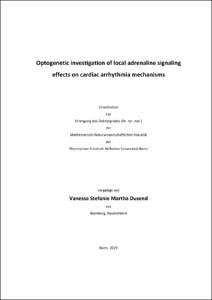Optogenetic investigation of local adrenaline signaling effects on cardiac arrhythmia mechanisms

Optogenetic investigation of local adrenaline signaling effects on cardiac arrhythmia mechanisms

| dc.contributor.advisor | Saße, Philipp | |
| dc.contributor.author | Dusend, Vanessa Stefanie Martha | |
| dc.date.accessioned | 2024-01-15T09:14:12Z | |
| dc.date.available | 2024-01-15T09:14:12Z | |
| dc.date.issued | 15.01.2024 | |
| dc.identifier.uri | https://hdl.handle.net/20.500.11811/11236 | |
| dc.description.abstract | Ventricular arrhythmias are one of the major causes of death worldwide, occurring especially in structurally remodeled hearts, but also in hereditary conditions, such as CPVT, in which mutations in RyR2 or Casq2 cause diastolic calcium leak. In this thesis optogenetic activation of the Gs-signaling pathway was used to investigate regionally specific effects of ß-adrenergic stimulation on ventricular arrhythmias, which could in the future lead to the development of more selective drug treatments with increased efficacy and reduced adverse effects. In mice expressing the blue light sensitive GPCR JellyOp and carrying a Casq2 knockout (Casq2 -/- JellyOp pos.) the influence of the regional sensitivity towards diastolic calcium leak induced VT trigger by Gs-signaling was investigated. The local stimulation of the endocardium and the epicardium with matching light intensities and area of illumination uncovered a more than ten-fold higher propensity for Gs-induced PVCs in the endocardium than the epicardium. High intrinsic sinus rhythm as well as fast ventricular pacing protected against Gs-induced PVCs. Pacing threshold in ChR2 expressing mice as well as quantitative analysis of JellyOp expression excluded differences in light application, receptor expression as well as excitability of the cardiomyocytes and thereby confirmed an inherent difference in the Gs-signaling response of the endocardium. PDE inhibition by IBMX did not abolish the endo- to epicardial difference, thus suggesting a regulatory mechanism downstream of cAMP. Western blot analysis of calcium handling proteins as well as PKA phosphorylation revealed a significant difference in phosphorylation levels of PKA phosphorylated proteins, and in particular PLN phosphorylation, with a higher relative increase in phosphorylation in the endocardium than the mid-myocardium upon adrenergic stimulation. Inducibility of reentry VTs was characterized using S1S2 electrical stimulation to generate a premature trigger during the vulnerable repolarization phase of the ventricle. Casq2 -/- JellyOp pos. hearts had significantly higher VT incidence after optogenetic Gs-stimulation. Voltage mapping of a S1S2 triggered excitation revealed increased conduction velocity heterogeneity and local, functional conduction block after illumination. In long-running monomorphic VTs, illumination significantly decreased VT frequency and in some cases led to the transition to a polymorphic VT with higher complexity of the ECG signal and destabilization of the rotor core observed in voltage mapping. In conclusion, optogenetic Gs-activation enabled regional discrimination of ß-adrenergic effects on ventricular arrhythmias, revealing that Gs-activation promotes VT trigger by generation of PVCs in the endocardium. Furthermore, optogenetic Gs-activation enhanced inducibility and maintenance of reentry VT and increased the risk of transition to higher frequency and complexity as observed in the transition to highly lethal VF in patients. In the future, identification of the new endocardial mechanism will help to develop concepts to prevent PVCs triggering VT. | en |
| dc.language.iso | eng | |
| dc.rights | In Copyright | |
| dc.rights.uri | http://rightsstatements.org/vocab/InC/1.0/ | |
| dc.subject | Optogenetik | |
| dc.subject | Kardiale Arrhythmien | |
| dc.subject | Gs-Signalweg | |
| dc.subject | JellyOpsin | |
| dc.subject | Adrenalin | |
| dc.subject | optogenetics | |
| dc.subject | cardiac arrhythmias | |
| dc.subject | Gs-signaling | |
| dc.subject | adrenaline | |
| dc.subject.ddc | 610 Medizin, Gesundheit | |
| dc.title | Optogenetic investigation of local adrenaline signaling effects on cardiac arrhythmia mechanisms | |
| dc.type | Dissertation oder Habilitation | |
| dc.identifier.doi | https://doi.org/10.48565/bonndoc-199 | |
| dc.publisher.name | Universitäts- und Landesbibliothek Bonn | |
| dc.publisher.location | Bonn | |
| dc.rights.accessRights | openAccess | |
| dc.identifier.urn | https://nbn-resolving.org/urn:nbn:de:hbz:5-73826 | |
| dc.relation.doi | https://doi.org/10.1038/s41467-019-09322-7 | |
| ulbbn.pubtype | Erstveröffentlichung | |
| ulbbnediss.affiliation.name | Rheinische Friedrich-Wilhelms-Universität Bonn | |
| ulbbnediss.affiliation.location | Bonn | |
| ulbbnediss.thesis.level | Dissertation | |
| ulbbnediss.dissID | 7382 | |
| ulbbnediss.date.accepted | 02.11.2023 | |
| ulbbnediss.institute | Medizinische Fakultät / Institute : Institut für Physiologie I | |
| ulbbnediss.fakultaet | Mathematisch-Naturwissenschaftliche Fakultät | |
| dc.contributor.coReferee | Kostenis, Evi | |
| ulbbnediss.contributor.orcid | https://orcid.org/0000-0001-7561-0178 |
Files in this item
This item appears in the following Collection(s)
-
E-Dissertationen (4137)




